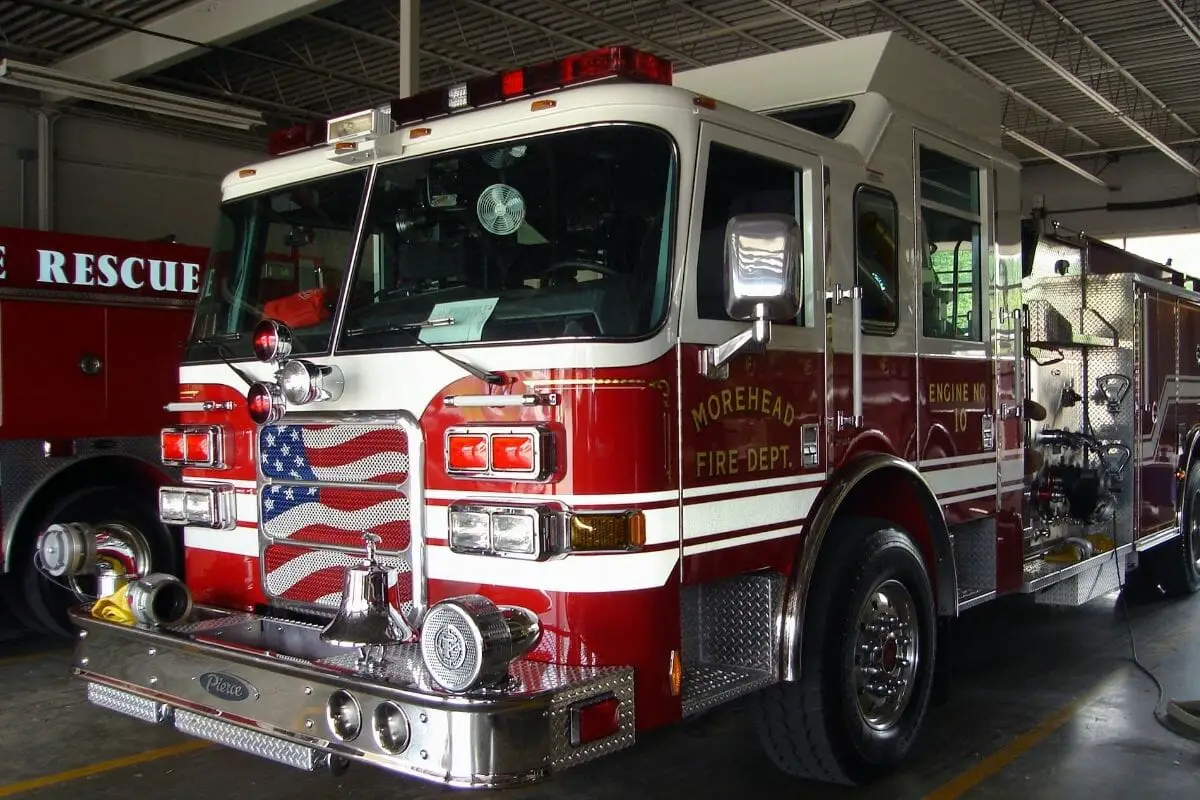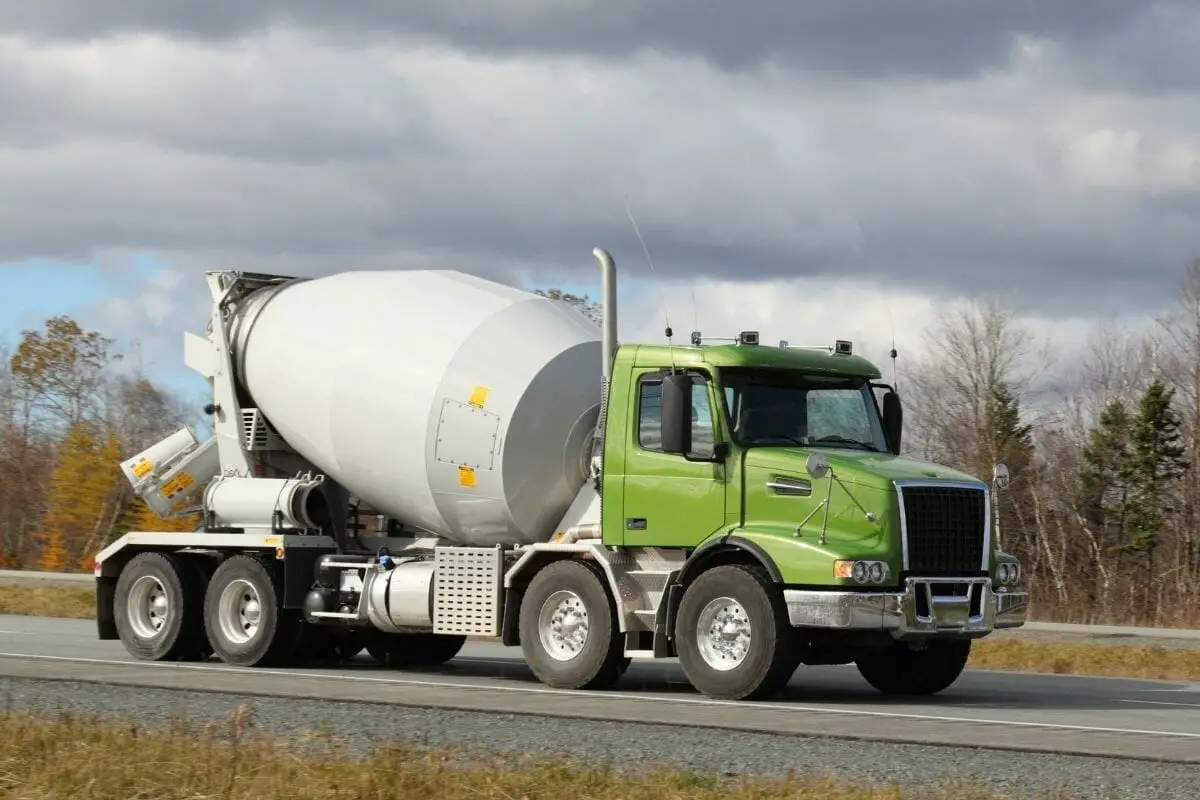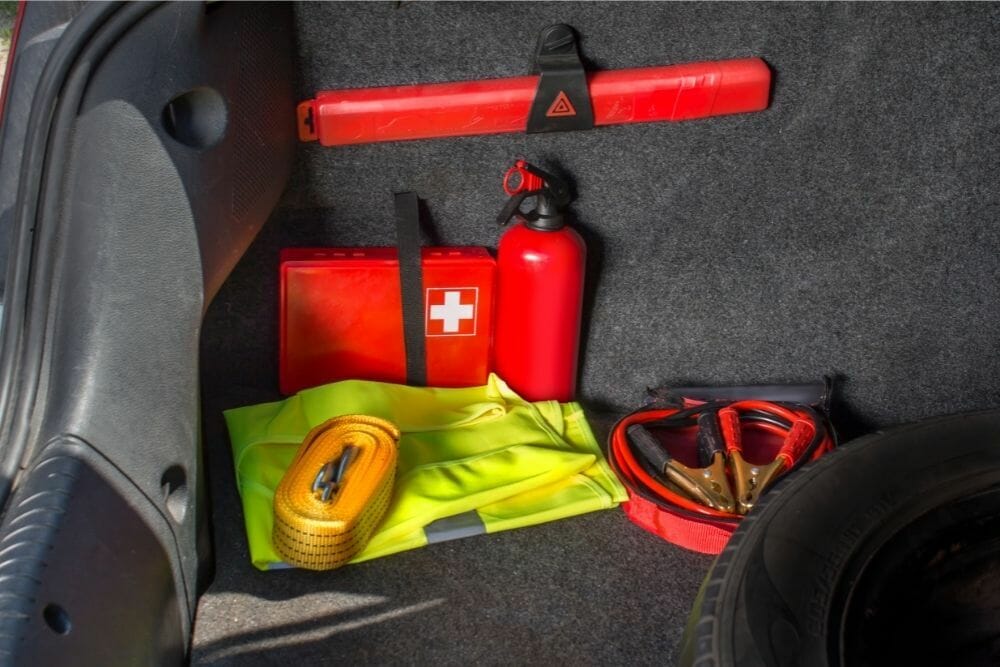Whenever we see a fire truck speeding down a street, we are not just impressed with the striking red color of the vehicle but also its size.

Fire trucks can be as long as 40 feet which makes them one of the largest vehicles on our city streets.
But a vehicle that size is not a lightweight. With all the equipment and tools, such as ladders, pumps and a large water tank, fire engines typically outweigh your standard truck.
The only other duty vehicles that are heavier than a fire truck are tractor trailers and garbage trucks.
In this article, we delve into the different weights of a fire truck. We discover the empty versus full weight, and compare the weight of a fire engine with other vehicles.
Keep in mind, there are differences between fire trucks and fire engines, although they are used interchangeably in this article.
How Much Do Fire Trucks Weigh?
The standard dimensions of a fire truck are around 10 feet wide, 12 feet tall and 40 feet long.
Depending on the type of fire truck, these dimensions can vary but even the smaller fire engines are around 35 feet long with a height and width of nine feet.
A truck of this size simply is extremely heavy. We checked with the Pennsylvania Department of Transport (PennDOT), and they said that the average fire truck has a weight between 19 and 30 tons.
This is between 38,000 and 60,000 pounds. This is the weight of a fire engine when it is full.
Although these vehicles are also heavy when they are empty, the majority of their weight is due to the large water tanks they carry.
The size of the water tank varies depending on the type of fire engine but on average they transport a minimum of 500 gallons of water.
In addition, fire trucks also have a large storage space for equipment, such as chainsaws, pumps and firefighting tools.
Typically, this equipment is made of sturdy metals which means it adds quite a lot of weight to the overall weight of the fire truck.
In a fire department, the driver engineer or fire equipment operator is commonly responsible for cleaning and maintaining the equipment, as well as all of the vehicles of a fire station.
He will ensure that all pumps, ladders and other tools are in working order, and that the fire trucks are ready to go in case of a callout to a fire.
The Weight Of Fire Trucks Compared To Other Vehicles
With their heavy weight of up to 60,000 pounds, fire trucks outweigh a lot of other vehicles on our roads.
Let’s take a look at some common vehicles that a fire truck outweighs.
Car
With a typical car weighing just 1.5 tons (3,000 pounds), it is much lighter than a fire truck’s average minimum weight of 30,000 pounds.
In fact, the lightest fire engine weighs around 10 times more than a car, and the heavier fire trucks come in at 20 times heavier than your average car.
Standard Truck
Your standard truck, which doesn’t cover a heavy-duty pickup truck, is just slightly heavier than your average car.
It comes in at a weight of around 3 tons (6,000 pounds). This means that the heaviest fire engine at 60,000 pounds is ten times heavier than the truck that you may be using every day on your way to work.
Ambulance
While cars and your average pickup truck are commonly used as normal vehicles, ambulances and fire trucks are exclusively used as emergency vehicles.
However, an ambulance is significantly lighter than a fire truck. With a weight of 5 tons (10,000 pounds), an ambulance is 20,000 pounds lighter than the smallest fire truck.
This is mainly thanks to the fact they have less equipment onboard. A much lighter weight and smaller size means that ambulances can find their way much faster through busy streets.
Delivery Truck
The standard delivery truck of a delivery company such as FedEx or UPS weighs just 6 tons (12,000 pounds).
Slightly heavier than an ambulance, these trucks are much lighter than a fire truck. Delivery trucks also carry a lot less load than fire engines.
School Bus
When the average yellow school bus is loaded with kids, then this vehicle can weigh 17 tons (34,000 pounds).
This is a similar weight to some of the smaller fire trucks but it is still a long way off from the 60,000 pounds of the heavier fire engines.
Charter Bus
A step up from the school bus, charter buses are very similar in weight to fire engines.
Although the size of charter buses can vary, the average type of charter bus has 60 seats, and as they typically transport adults (rather than kids), they are heavier than a school bus.
A full charter bus can weigh up to 20 tons, which is around 40,000 pounds.
Vehicles That Are Heavier Than A Fire Truck

As we have seen already, fire trucks are much heavier than the majority of other vehicles on the road.
However, they are not the weightiest vehicles that you can see. There are a number of other vehicles that outweigh fire trucks easily.
Garbage Truck
They may not look that heavy from a distance, but when you see a garbage truck close up, you will find yourself standing in front of a heavy beast.
Garbage trucks can weigh up to 25 tons (50,000 pounds) when they are full. This makes them almost as heavy as some of the heavier fire engines.
The main reason why these trucks are so weighty is because they have a heavy mechanism that helps store and crush the trash into smaller chunks so more fits in.
Snow Plow Truck
Another vehicle that is heavier than you might expect is the snow plow truck. These heavy-duty vehicles vary in weight, depending on the type of attachment at the front.
The average snow plow truck weighs 28 tons (56,000 pounds) which is almost as heavy as the heaviest fire engine.
Cement Truck
Cement trucks are very heavy-duty vehicles that can weigh 33 tons (66,000 pounds) when they are full.
A cement truck outweighs the heaviest fire engine which is only 60,000 pounds.
The reason why cement trucks are so heavy is because of the hefty cement that they carry.
Dump Trucks
You may think that a dump truck is a similar weight to a garbage truck but they are quite a bit more than that.
A dump truck that is fully loaded can weigh up to 36 tons (72,000 pounds). This is 12,000 pounds heavier than the heaviest fire engine.
Tractor Trailers
Heavy-duty tractor trailers are one of the heaviest vehicles on our roads. They do not just carry the trailer weight but also the weight of their load.
When you take tractor trailers, they can weigh up to 40 tons (80,000 pounds). That’s an incredible 20,000 pounds more than the biggest fire engine.
How Much Does An Empty Fire Truck Weigh?
Although fire engines may not be the heaviest heavy-duty vehicles on our roads, their weight between 38,000 pounds and 60,000 pounds definitely makes them one of the heavier ones out there.
However, this weight calculation includes all the firefighting equipment, water and other tools that firefighters need at the scene of a fire.
But what does a fire truck weigh when it is empty? The answer may surprise you.
According to data from the Office of Energy Efficiency and Renewable Energy, an empty fire truck can weigh between 11,500 and 14,500 pounds.
While this is still much heavier than the average car, pickup truck and minibus, this is a fraction of what a fire truck weighs when it is full.
This shows that the equipment, such as ladders, pumps and the water tank, add a large chunk of weight to the fire engine’s overall weight.
Does A Fire Truck Have To Stop At Weigh Stations?

Fire trucks are emergency vehicles that are essential for the fire safety in a city. However, they are not just used to put out a fire, but also to get to and from the fire station.
While they can react faster to get to a blaze, fire trucks have to follow speed limits and regulations on the way back to the fire station.
This means that they may pass a weigh station at some point when on duty.
Weigh stations are highway checkpoints that weigh heavy-duty vehicles to ensure that they adhere to weight regulations and laws.
The weigh station is essentially a large scale where the vehicle is driven on and weighed.
The fire truck needs to be in a certain weight range. If this is not the case, then there may be further inspection needed.
If the vehicle is found to be overweight, then the fire department may break state laws and the fire truck may not be allowed to operate until the weight is corrected.
However, not all vehicles are required to stop at weigh stations.
In the majority of states, vehicles heavier than 10,000 pounds need to pass the test in a weigh station successfully, in order to continue their journey.
Vehicles that weigh more than 10,000 pounds are classified as commercial vehicles.
With that said, fire trucks are not classified as commercial vehicles, although they exceed the 10,000 pound weight mark easily.
This means that they do not have to stop at a weigh station.
What Does It Feel Like Driving A Heavy Fire Engine?
Heavy fire trucks do not drive like a smaller car or even like an ambulance.
If you are a firefighter or a driver engineer working for a fire department, then you know that driving these heavy-duty vehicles is something special each time you get in.
Not every firefighter is allowed to operate equipment or drive a fire engine.
Only driver engineers or apparatus operators (AO) have received the appropriate training to drive these vehicles.
If you have previous experience in driving other heavy-duty vehicles, such as cement trucks or garbage trucks, then driving a fire truck is very similar.
However, if you only have prior experience in driving a pickup truck or even a delivery truck, then you will need suitable training to transition into navigating a fire engine which is much heavier.
It is not just about the weight, however. Fire trucks are also longer and larger than most other vehicles on the road.
You need to develop a feeling for the larger dimensions in order to drive a fire truck safely.
While driving a small car, we do not typically think much about the length but when you drive a fire engine, you need to consider the rear end of the vehicle each time you turn.
You need to make sure that you allow enough space on each side for the turn. This is crucial to ensure the safety of other road users and also the fire truck.
Steering a vehicle of this size and this heavy is very difficult. Due to its weight, it is also tricky to gain speed which means that you need to maneuver the streets and hold a constant speed.
Conclusion
As we have seen, fire engines are heavy vehicles. They can weigh as much as 60,000 pounds which means that they are heavier than a yellow school bus.
However, they are not the heaviest vehicle on the road, compared to cement trucks and tractor trailers, which are the weightiest road vehicles.








